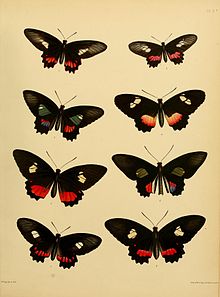Parides panares
| Wedge-spotted cattleheart | |
|---|---|

| |
| Figure 4 accompanying Gray's original description | |
| Scientific classification | |
| Kingdom: | |
| Phylum: | |
| Class: | |
| Order: | |
| Family: | |
| Tribe: | |
| Genus: | |
| Species: | P. panares
|
| Binomial name | |
| Parides panares (Gray, [1853])
| |
| Synonyms | |
| |
Parides panares, the wedge-spotted cattleheart,[1] is a species of butterfly in the family Papilionidae native to the Americas. The larvae feed on Aristolochia maxima and A. pilosa.[2]
Subspecies
- P. p. panares (Gray, [1853]) (southeastern Mexico)[2]
- P. p. erythrus (Rothchild & Jordan, 1906) (Panama to Colombia)[2]
- P. p. lycimenes (Boisduval, 1836) (southeastern Mexico to Panama)[2][3]
- P. p. paralius (Rothchild & Jordan, 1906) (Ecuador)[2]
- P. p. rachelii K. S. Brown, 1994 (northern Venezuela)[2]
- P. p. tachira T. Racheli, 1991 (southwestern Venezuela)[2]
Description from Seitz
[panares panares = iphidamas in Seitz (misident.) Mexico] P. lycimenes. Male : somewhat smaller than P. vertumnus, the red area of the hindwing less triangular and its last spot smaller. Female: forewing slightly transparent at the apex; the spots somewhat yellowish, not pure white, the cell-spot usually large and extended across the cell; band of the hindwing less bright red than in P. vertumnus. Tibiae of the male not thickened. Guatemala to Ecuador, in several subspecies. — lycimenes Boisd. is the Central American form. Forewing with a large green spot, which almost always encloses at least one white spot; often a spot in the cell; hindwing with 4—6 red spots. In the female the yellowish white spot before the 1.median much larger than the preceding one; band of the hindwing broad, almost always a uniform bright red. Guatemala to Panama; also on the small islands on the west coast of the Republic of Panama. — erythrus R. & J. (3d), male : the green spot broader than in the preceding form, reaching to the hindmargin of the wing. Female: the spot before the 1.median of the forewing larger than in the preceding form; the band of the hindwing paler. Central and East Colombia and North Venezuela. — paralius R. & .J. (4a). Small, male : forewing with round yellow-white spot before the 2. median; band of the hindwing short and narrow. Female: spot on the forewing purer white than in the previous subspecies, the cell-spot reduced; the spot before the 2. median the largest; band of the hindwing almost straight. West Ecuador.[4]
-
Seitz Plate 3
-
Seitz Plate 4
Description from Rothschild and Jordan(1906)
A full description is provided by Rothschild, W. and Jordan, K. (1906)[5] See note on synonymy under Seitz (above).
Taxonomy
Parides panares is a member of the anchises species group [6]
The members are
- Parides anchises
- Parides cutorina
- Parides erithalion
- Parides iphidamas
- Parides panares
- Parides phosphorus
- Parides vertumnus
References
- ^ Warren, A. D.; et al. (2010). "Parides panares". Butterflies of America. Retrieved 21 January 2011.
- ^ a b c d e f g Savela, Markku. "Parides panares". funet.fi. Retrieved 21 January 2011.
- ^ Lewis, H. L., 1974 Butterflies of the World ISBN 0-245-52097-X Page 26, figure 13
- ^ Seitz, A. ed. Band 1: Abt. 1, Die
Großschmetterlinge des palaearktischen Faunengebietes, Die palaearktischen Tagfalter, 1909, 379 Seiten, mit 89
kolorierten Tafeln (3470 Figuren)
 This article incorporates text from this source, which is in the public domain.
This article incorporates text from this source, which is in the public domain.
- ^ Rothschild, W. and Jordan, K. (1906). A revision of the American Papilios. Novitates Zoologicae 13: 411-752. (Facsimile edition ed. P.H. Arnaud, 1967) and online
- ^ Edwin Möhn, 2007 Butterflies of the World, Part 26: Papilionidae XIII. Parides Verlag Goecke & Evers Verlag Goecke & Evers ISBN 9783937783277
Further reading
- Lamas, Gerardo (2004). Atlas of Neotropical Lepidoptera; Checklist: Part4A Hesperioidea–Papilionoidea. Gainesville, Florida: Scientific Publishers, Inc. p. 93. ISBN 0-945417-28-4.


